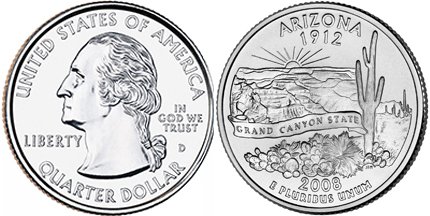Arizona State Quarter
Category: Arizona

Arizona was incorporated into the Union on the 14th of February 1912, turning out to be the 48th state of the United States, and the last state in the continental United States. The third remembrance quarter-dollar coin was released on the 2nd of June 2008 honors the state of Arizona, and it is the 48th coin in the 50 State Quarters Program of the United States Mint.
The Arizona state quarter features a picture of the Grand Canyon with the foreground of a Saguaro cactus. A poster reading "Grand Valley State" divides the two pictures to mean that the Saguaro desert cactus does not develop in the Grand Valley. The coin bears the writings "1912" and "Arizona", as well. The coin was engraved by Joseph Menna, and it weighs 5.670 grams, with the diameter of 0.955 inches (24.26mm) and a thickness of 0.07 inches (1.75 mm). The coin is made up of nickel and copper with the percentage of 8.33% of Nickel and 91.67% of Copper.
One among the world’s seven natural wonders, the Grand Valley covers an area in excess of 1.2 million acres in the northwestern part of the Arizona State. The Canyon, carved by the impressive Colorado River, with a depth of 6,000 feet (1818 meters) at its deepest point and 28.8 km (18 miles) at its widest. It is an abode to many uncommon and threatened animal and plant species. During 1919, the Grand Canyon connected the National Park scheme and is visited by over four million sightseers a year.
History
Humans existed in the Arizona region 20,000 years ago. Hints of early farming civilizations are discovered all through the state. High, more or less unreachable cliff homes still stand in unspoken proof of another prehistoric race. Even the measureless irrigation system neighboring Phoenix, the Arizona capital city, follows the prehistoric patterns of canals exploited to irrigate the farmlands of the Hohokam village with water from the Salt and Gila Rivers.
Back in the periods of formation of the Arizona State, there had been shaped in Arizona land immense deposits of silver, gold, copper and other deposits that were currently exposed by the prospectors. Lusty novel towns sprang up close to the mines.
Great affluences were prepared and lost, occasionally in 24 hours only. Though prospectors were "striking it wealthy," other pioneers saw their chances of the future in another feature of the land feature of the Arizona land. Farmers developed crops along streams and rivers like the Indians had done before them. Others introduced cattle to graze the range land. Some others saw the state of Arizona a perfect place to develop sheep.
Current situation
By means of the abrupt growth of the frontier, the law and order were leisurely to catch up. Harsh gun fights broke out between the sheep men and cattle men, each requiring the water and the grazing land rights. Through the control of the pioneers themselves, finally, United States Marshals have made a serene land of Arizona, where cattle, crops, and sheep, in addition to mining, all became vital in constructing the future of the Arizona state quarter. During 1912, the lawless, energetic frontier days behind Arizona, it turned into the 48th state to join the Union and its contemporary progress commenced.

 Back To Category Arizona
Back To Category Arizona